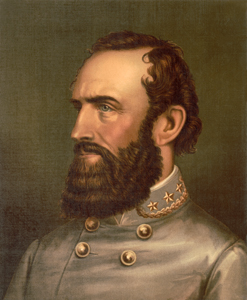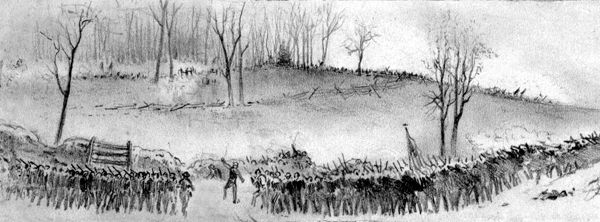Jackson’s Valley Campaign was a Confederate campaign led by Major General Thomas J. “Stonewall” Jackson through the Shenandoah Valley of Virginia. During the Civil War, the Shenandoah Valley was one of the most strategic areas of Virginia. It was an agriculturally rich area with millions of bushels of wheat produced and plenty of livestock, which were used to provision Virginia’s armies and the Confederate capital of Richmond. Stonewall Jackson wrote to a staff member, “If this Valley is lost, Virginia is lost.” The campaign lasted from March through June 1862.
Utilizing unpredictable movements on interior lines, Jackson’s 17,000 men marched 646 miles in 48 days and won several minor battles as they successfully engaged three Union armies, preventing them from reinforcing the Union offensive against Richmond. The successful Confederate campaign resulted in 5,307 Union casualties and 2,677 Confederate.
Kernstown – (March 23, 1862) – Taking place in Frederick County and Winchester, Virginia, this was the first battle of “Stonewall” Jackson’s campaign through the Shenandoah Valley. Relying on faulty intelligence that reported the Union garrison at Winchester numbered only about 3,000, “Stonewall” Jackson marched aggressively north with his 3,400-man division. The 8,500 Federals, commanded by Colonel Nathan Kimball, stopped Jackson at Kernstown and then counterattacked, turning Jackson’s left flank and forcing him to retreat. Despite this Union victory, President Abraham Lincoln was disturbed by Jackson’s threat to Washington and redirected substantial reinforcements to the Valley, depriving Union General George McClellan’s army of these troops. McClellan claimed that the additional troops would have enabled him to take Richmond during his Peninsula Campaign. It was Jackson’s sole defeat during the Civil War. Of the 12,300 total troops engaged, the Union suffered 590 casualties and the Confederates – 718.
McDowell (May 8, 1862) – Also called the Battle of Sitlington’s Hill, this battle took place in Highland County. From Staunton, Virginia, Major General Thomas J. “Stonewall” Jackson marched his army west along the Parkersburg Road to confront two Union brigades under the commands of Brigadier General Robert C. Schenck and Brigadier General Robert H. Milroy, who were advancing toward the Shenandoah Valley from western Virginia. At McDowell on May 8th, Milroy seized the initiative and assaulted the Confederate position on Sitlington’s Hill. The Federals were repulsed after severe fighting, lasting four hours. Afterward, Milroy and Schenck withdrew into western Virginia, freeing up Jackson’s army to march against the other Union columns threatening the Valley. The Confederate victory resulted in an estimated 720 casualties.
Front Royal (May 23, 1862) – Also called the Battle of Guard Hill or Cedarville, this battle took place in Warren County. On May 23rd, Confederate forces, spearheaded by Major Roberdeau Wheat’s Louisiana “Tigers” battalion and the 1st Maryland Infantry, surprised and overran the pickets of a 1,000-man Union garrison under Colonel John R. Kenly at Front Royal. Driven through the town, the Federals stood on Camp Hill and again at Guard Hill after attempting to fire the river bridges. Outnumbered and outflanked, Kenly continued the retreat to Cedarville, where Major Thomas L. Flournoy’s two cavalry charges broke the roadblock and routed the Union force. Nearly 900 Federals surrendered. Jackson’s victory at Front Royal forced the Union army under Major General Nathaniel P. Banks, at Strasburg, into a rapid retreat towards Winchester. The Confederate victory resulted in an estimated 904 Union casualties and 56 Confederate casualties.
Winchester I (May 25, 1862) – Also known as the Battle of Bowers Hill, this large engagement took place in Frederick County and Winchester, Virginia. After skirmishing with Major General Nathaniel P. Banks’s retreating army at Middletown and Newtown on May 24th, Major General Thomas J. “Stonewall” Jackson’s division continued north on the Valley Pike toward Winchester. There, Banks was attempting to reorganize his army to defend the town. Confederate Major General Richard S. Ewell’s division converged on Winchester from the southeast using the Front Royal Pike. On May 25th, Ewell attacked Camp Hill, while the Louisiana Brigade of Jackson’s division outflanked and overran the Union position on Bowers Hill. Panic spread through the Federal ranks, and many fled through Winchester. Banks’ army was soundly defeated and withdrew north across the Potomac River. This was a decisive battle in Jackson’s Valley Campaign. With some 22,500 troops engaged, the Union suffered 2,019 casualties and the Confederates, 400.
Cross Keys (June 8, 1862) – Taking place in Rockingham County, this battle took place as Union Major General John C. Fremont’s army was pursuing Jackson’s Confederate troops in the Shenandoah Valley. On June 8th, Fremont’s army encountered Confederate Major General Richard S. Ewell’s division at Cross Keys. Union General Julius Stahel’s brigade, attacking the Union left, was stunned by a surprise volley from Confederate Brigadier General Isaac R. Trimble’s command and driven back in confusion. After feeling out other parts of the Confederate line, General Fremont withdrew to the Keezletown Road under his batteries’ protection. The next day, General Trimble’s and Colonel George Patton’s brigades held Fremont at bay, while the rest of Ewell’s force crossed the river to assist in the defeat of Brigadier General E. Tyler’s command at Port Republic. The Confederate victory resulted in 664 Federal casualties and 287 Confederate casualties.
Port Republic (June 9, 1862) – Taking place in Rockingham County, this battle occurred when Major General Thomas J. “Stonewall” Jackson concentrated his forces east of the South Fork of the Shenandoah River against the isolated brigades Brigadier General Erastus B. Tyler and Colonel Samuel Carroll. Confederate assaults across the bottomland were repulsed with heavy casualties, but a flanking column turned the Union left flank at the Coaling. Union counterattacks failed to reestablish the line, and General Tyler was forced to retreat. Confederate forces at Cross Keys marched to join General Jackson at Port Republic, burning the North River Bridge behind them. General Fremont’s army arrived too late to assist Tyler and Carroll and watched helplessly from across the rain-swollen river. After these dual defeats at Cross Keys and Port Republic, the Union armies retreated, leaving Jackson in control of the upper and middle Shenandoah Valley and freeing his army to reinforce General Robert E. Lee. The Confederate victory resulted in 1,002 Union casualties and 816 Confederate.
Compiled and edited by Kathy Weiser-Alexander/Legends of America, updated May 2021.
Also See:
Sources:
Battlefields.org
National Park Service Battle Descriptions (no longer available online)
National Park Service Civil War
Wikipedia



